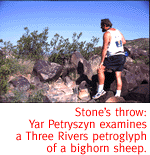
Mysterious Images In Stone Whisper To Us Through The Ages.
By Kevin Franklin
EVERYWHERE I LOOK, I can't help but see petroglyphs. Pecked into the stone are haunting images of bighorn sheep, snakes, birds, geometric shapes, people, masks, turtles--and one that
looks like a man battling a house cat. More than 21,000 petroglyphs
adorn the rocks here at the Bureau of Land Management's Three
Rivers Petroglyph Site in New Mexico.
This is one of the most impressive and important of such sites
in the world, and two friends and I have it all to ourselves this
early morning.
 Off to the west stand the San Andreas Mountains, and in the far
distance I can make out the glaring streak from the gypsum dunes
of White Sands National Monument. Immediately to the east stand
the Sierra Blanca Mountains. Peaking at more than 12,000 feet,
they're the southernmost place in the continental United States
to find a tundra ecosystem. The mountains are also the easternmost
extent of the basin and range topography that shapes most of Arizona
and much of the Southwest.
Off to the west stand the San Andreas Mountains, and in the far
distance I can make out the glaring streak from the gypsum dunes
of White Sands National Monument. Immediately to the east stand
the Sierra Blanca Mountains. Peaking at more than 12,000 feet,
they're the southernmost place in the continental United States
to find a tundra ecosystem. The mountains are also the easternmost
extent of the basin and range topography that shapes most of Arizona
and much of the Southwest.
Still, it isn't this impressive list of geologic credentials
that fires my imagination. It's the images left by these long-gone
people that set my mind to wander in the past. Archeologists call
them the Jornada Mogollon, the desert-dwelling cousins
to the Mimbres Mogollon. They lived here 1,000 years
ago. Despite that giant expanse of time, it's easy to imagine
them looking up from their village here at the Sierra Blancas.
When I see a petroglyph of a bear track, I look up into those
green canyons and forested peaks. I feel a direct link to the
person who made that petroglyph. I know the artist also looked
up into those mountains, in the direction the track faces, and
thought about the bears living there.
Today there's no time to explore the wilds of the Sierra Blancas,
but we do have time to hike along a trail that takes us through
boulder fields covered in petroglyphs.
I've seen sites with lots of petroglyphs before, but no other
place offers such diversity. Some petroglyphs, like one that uses
a nodule to form the eye of bighorn sheep, are very realistic.
Others are extraordinarily complex geometric designs, with no
obvious meaning. Particularly striking is a stylized bighorn with
a body made of Mimbres-style geometric shapes pierced by arrows.
The most unsettling is a dramatically life-like picture of a person
with Mesoamerican features and earrings. The riveting image looks
like something from Costa Rica, not the remote Southwest. The
artist may have been inspired by trade items from that culture;
or perhaps the artist was from Central America and made the petroglyph
while passing through.
 This region was in the midst of a vast trade network stretching
from the Pacific to the Gulf Coast, and from the Anasazi Pueblo
strongholds of the north to the deep southern reaches of Mesoamerica,
Meliha Duran writes in a Bureau of Land Management field research
report on the area. Three Rivers sits right in between the Rio
Grande and the Pecos River. It's an obvious stopover between those
two ancient highways.
This region was in the midst of a vast trade network stretching
from the Pacific to the Gulf Coast, and from the Anasazi Pueblo
strongholds of the north to the deep southern reaches of Mesoamerica,
Meliha Duran writes in a Bureau of Land Management field research
report on the area. Three Rivers sits right in between the Rio
Grande and the Pecos River. It's an obvious stopover between those
two ancient highways.
Alex Patterson has written a handy field guide, Rock Art Symbols
of the Greater Southwest, for anyone interested in attempting
to decipher the meaning of various figures.
Taking figures from all over the Southwest, Patterson has researched
what 150 authors theorize they might mean. His sources are archeologists,
Native Americans, historians and others, both past and present.
While Patterson acknowledges no exact definition can be ascribed
for any given petroglyph, patterns in their general meaning do
begin to emerge. Eventually reasonable guesses can be made, especially
when put into context.
Where the inspiration for these works came from, or their exact
meanings, will probably forever remain a mystery. Despite this,
or maybe because of it, they haven't lost their impact with the
passing of time. They stand on their own as remarkable pieces
of artwork. But more than that, they're symbolic messages from
a culture long gone before Columbus sailed across the Atlantic.
Those are messages worth contemplating, even if they can never
be understood.
Getting There
Three Rivers Petroglyph Site is five miles east off Highway
54, in New Mexico. Call (505) 525-4300 for more information.

|





